
I took a deep breath and sat down, my mind racing with possibilities, each more unsettling than the last. The photographer, Mr. Caldwell, leaned over the desk, his expression a mix of apprehension and sincerity.
“I’m sorry to have alarmed you,” he began, his voice barely above a whisper. “But I felt you needed to see these before anyone else.”
He opened the laptop and clicked through several folders until he found the one he was looking for. As the first image filled the screen, I blinked in confusion. The photo seemed normal enough—a candid shot of David and Jessica laughing during the reception. I leaned in closer, searching for whatever anomaly had prompted this midnight meeting.
“Look here,” Mr. Caldwell said, zooming in on a particular part of the photo. “Do you see anything unusual?”
It took a moment for my eyes to adjust, but then I saw it—a faint, almost imperceptible figure standing in the background, partially obscured by the crowd. It was a woman, dressed in a style that seemed out of place at a wedding, her expression solemn and her eyes fixed directly at the camera.
“Who is that?” I asked, my voice strained.
“That’s the question,” he replied, clicking to the next photo. In this one, the mysterious figure appeared again, closer this time, her features more defined but still unfamiliar. “She shows up in nearly every picture, but no one at the wedding remembers seeing her.”
I felt a chill run down my spine. “Did you ask the venue staff? Check the guest list?”
He nodded. “I did. She wasn’t on any lists, and the staff swear they didn’t see anyone matching her description. I even looked through security footage from that night. There’s no record of her arriving or leaving.”
My heart pounded as I tried to rationalize what I was seeing. Perhaps she was a guest who simply didn’t RSVP, or a friend of Jessica’s family. But Mr. Caldwell’s grave demeanor suggested something more.
“There’s one more thing,” he said, his fingers hovering over the keyboard as if he were hesitant to proceed. “I did some research based on facial recognition. I wasn’t sure I’d find anything, but…”
He pulled up a grainy black-and-white newspaper clipping on the screen next to the photos. The headline read: “Local Woman Mysteriously Disappears – 1985.” Below it was a photograph of the missing woman, her face unmistakably the same as the ghostly figure in my son’s wedding photos.
I gasped, recoiling from the screen. It wasn’t possible. Yet there she was, a specter from the past inexplicably present in our lives.
“I don’t know what this means,” Mr. Caldwell admitted, his voice tinged with an unsettling mixture of wonder and fear. “But it seems like she’s trying to convey something. Maybe to you, maybe to your family. I thought you should know.”
I sat in silence, the weight of the revelation pressing down on me. The night that was meant to celebrate love and new beginnings had somehow become entangled with a decades-old mystery. I realized then that I was standing at a crossroads, confronted with truths that demanded to be acknowledged, no matter how inexplicable they seemed.
“Thank you for showing me,” I finally said, my voice steady with resolve. “I need to think about what to do next.”
As I left the studio and drove back through the sleeping city, I couldn’t shake the feeling that the past was not as distant as I’d believed. The images lingered in my mind, a reminder that some stories refuse to remain untold, and that the truth, once revealed, can alter everything.
“When My Baby Was Born, the Doctor Asked If I Accepted the Child — But My Words Stunned Him” 👶💔➡️💖
The delivery room was bright, cold, and strangely quiet. I remember lying there, exhausted after hours of labor, my heart pounding not only from the effort but from fear. I had waited nine long months for this moment — dreaming, imagining, hoping — and yet nothing prepared me for what was about to happen. 💭❤️
When the doctor finally lifted my baby into his arms, something in the room shifted. His expression changed. His eyebrows tightened, his lips pressed into a thin line. Nurses exchanged uneasy glances. I felt the air grow heavy.
“Is… is something wrong?” I whispered, barely able to breathe. 😟
He didn’t answer immediately. Instead, he wrapped the baby carefully, almost too slowly, and then turned to me. His face was gentle, but his eyes… his eyes were full of something between pity and hesitation.
He cleared his throat.
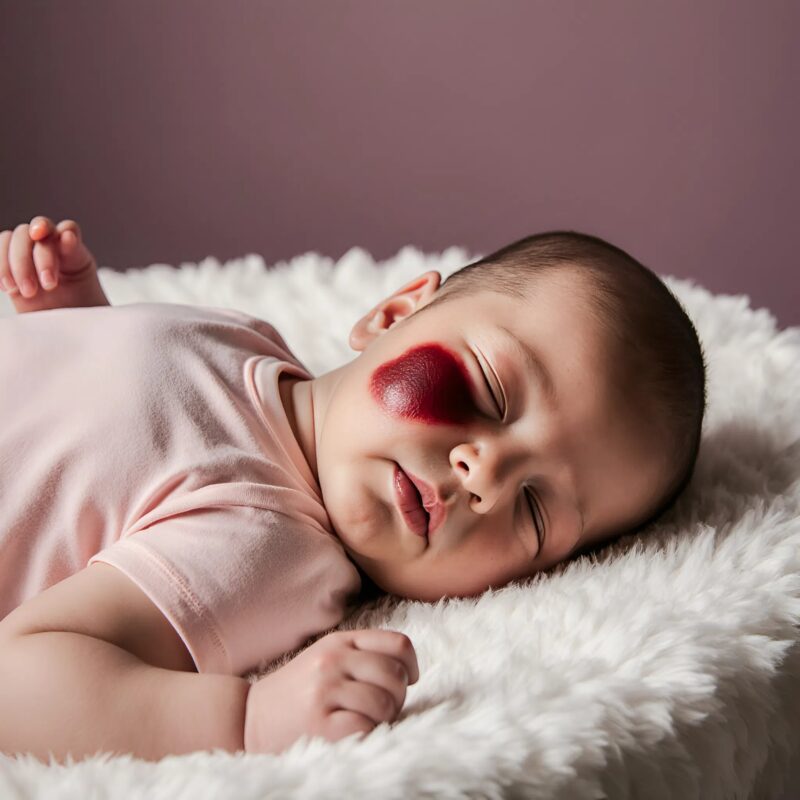
“Do you accept the baby or reject it?” he asked quietly.
The words sliced through the silence like a blade. ❌💔
For a moment, I couldn’t speak. Couldn’t move. Couldn’t even understand. Reject? My baby? What did that even mean?
My mind raced through every possibility — a medical problem, a deformity, a disability they feared I wouldn’t handle. My heart clenched as fear washed over me. 😣💔

“Why would you ask me that?” I finally whispered.
The doctor sighed. “Because… some parents choose not to take the child when there are unexpected complications.”
The nurse placed a tiny bundle into my arms. My hands trembled as I pulled the blanket back to see the little face that had changed my life before even taking a breath.
And at that exact moment… everything stopped.
My baby had the softest eyes I had ever seen, a tiny wrinkle above the nose, and a mouth shaped like a delicate heart. Nothing about this child looked like something to reject. Nothing. 💕👶

I felt tears gathering before I even spoke.
I lifted my head, stared straight at the doctor, and said the words that stunned him — words that came from the deepest part of my soul:
“This is my child. I don’t reject what I love before I even know it.” ❤️
The doctor blinked, startled. The nurse covered her mouth. Another nurse wiped her eyes. The room, once cold and heavy, warmed instantly — as if the walls themselves sighed with relief. 😊✨

I pressed my baby to my chest and whispered, “You’re mine. Exactly as you are. Exactly as you were meant to be.” 💞🌈
The doctor nodded slowly, almost respectfully, and murmured, “Then we’ll do everything we can to support you. Your child is lucky.”
But he was wrong.
I was the lucky one. 💖

The first months were difficult. Countless appointments, sleepless nights, worries that felt too heavy for one person to carry. But every challenge was matched with double the joy — the first smile, the first laugh, the tiny hand gripping my finger like it would never let go. 🥹✨
People often looked at us with curiosity. Some whispered. Some asked inappropriate questions. But none of that mattered.
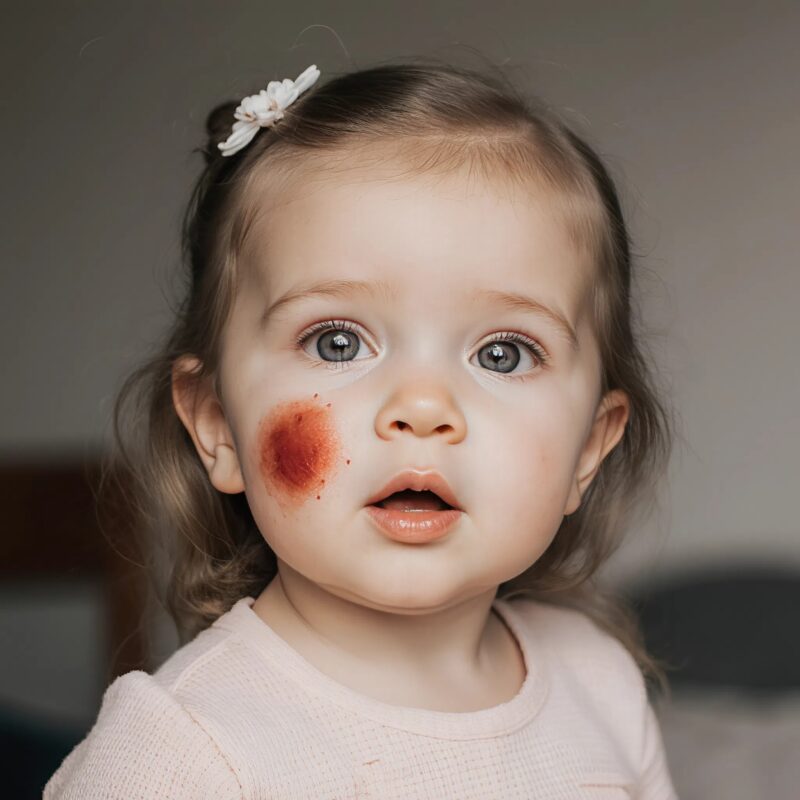
Today, my baby is three years old. 🎉👶💫
Three years of laughter.
Three years of growth.
Three years of proving everyone wrong.
And every time I look into those same soft eyes from the day of birth, I think:
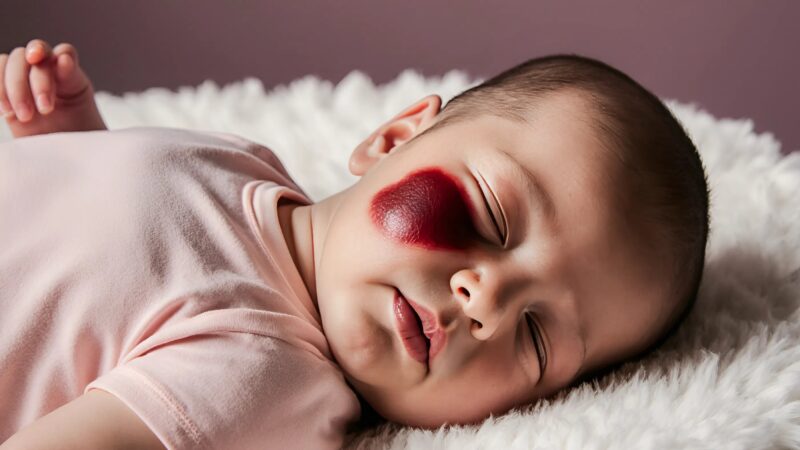
“I didn’t choose acceptance. I chose love.” ❤️✨
The delivery room was bright, cold, and strangely quiet. I remember lying there, exhausted after hours of labor, my heart pounding not only from the effort but from fear. I had waited nine long months for this moment — dreaming, imagining, hoping — and yet nothing prepared me for what was about to happen. 💭❤️
When the doctor finally lifted my baby into his arms, something in the room shifted. His expression changed. His eyebrows tightened, his lips pressed into a thin line. Nurses exchanged uneasy glances. I felt the air grow heavy.
“Is… is something wrong?” I whispered, barely able to breathe. 😟
He didn’t answer immediately. Instead, he wrapped the baby carefully, almost too slowly, and then turned to me. His face was gentle, but his eyes… his eyes were full of something between pity and hesitation.
He cleared his throat.

“Do you accept the baby or reject it?” he asked quietly.
The words sliced through the silence like a blade. ❌💔
For a moment, I couldn’t speak. Couldn’t move. Couldn’t even understand. Reject? My baby? What did that even mean?
My mind raced through every possibility — a medical problem, a deformity, a disability they feared I wouldn’t handle. My heart clenched as fear washed over me. 😣💔

“Why would you ask me that?” I finally whispered.
The doctor sighed. “Because… some parents choose not to take the child when there are unexpected complications.”
The nurse placed a tiny bundle into my arms. My hands trembled as I pulled the blanket back to see the little face that had changed my life before even taking a breath.
And at that exact moment… everything stopped.
My baby had the softest eyes I had ever seen, a tiny wrinkle above the nose, and a mouth shaped like a delicate heart. Nothing about this child looked like something to reject. Nothing. 💕👶

I felt tears gathering before I even spoke.
I lifted my head, stared straight at the doctor, and said the words that stunned him — words that came from the deepest part of my soul:
“This is my child. I don’t reject what I love before I even know it.” ❤️
The doctor blinked, startled. The nurse covered her mouth. Another nurse wiped her eyes. The room, once cold and heavy, warmed instantly — as if the walls themselves sighed with relief. 😊✨

I pressed my baby to my chest and whispered, “You’re mine. Exactly as you are. Exactly as you were meant to be.” 💞🌈
The doctor nodded slowly, almost respectfully, and murmured, “Then we’ll do everything we can to support you. Your child is lucky.”
But he was wrong.
I was the lucky one. 💖

The first months were difficult. Countless appointments, sleepless nights, worries that felt too heavy for one person to carry. But every challenge was matched with double the joy — the first smile, the first laugh, the tiny hand gripping my finger like it would never let go. 🥹✨
People often looked at us with curiosity. Some whispered. Some asked inappropriate questions. But none of that mattered.

Today, my baby is three years old. 🎉👶💫
Three years of laughter.
Three years of growth.
Three years of proving everyone wrong.
And every time I look into those same soft eyes from the day of birth, I think:

“I didn’t choose acceptance. I chose love.” ❤️✨
The courtroom had fallen into that tense, airless silence that comes after a sentence is handed down. “Guilty. Life imprisonment,” the judge said, his tone heavy but steady. The shuffling of papers followed, the quiet rustle of people trying to move past someone else’s tragedy. Then came the voice that stopped everything. “Your Honor,” the man in the orange jumpsuit said, “I have one request. My son was born last week. I’ve never held him. Please… may I see him?” The judge studied the prisoner’s face—a mix of regret and resolve—and after a long pause, he nodded. The side door opened, and a young woman entered, clutching a small bundle wrapped in blue. The cuffs came off, and trembling hands reached forward. When the baby settled into his arms, the world seemed to still. “I’m sorry,” the man whispered. “Forgive me for not being there.”
Then the newborn went limp. Gasps cut through the silence. The mother froze; a deputy reached for the child. But the father didn’t panic. His voice softened. “It’s okay. You’re safe.” He held the baby in a “C” cradle, two fingers tracing gently down the tiny spine—the same technique he had learned in a prison parenting class taught by a retired nurse who drove three hours every Thursday to reach men most people had forgotten. For one suspended heartbeat, nothing happened. Then came a cough. Another. And finally, the unmistakable cry of life returning. Relief washed through the room like a sudden sunrise. The mother wept. Even the bailiff turned away to hide his tears. The judge simply whispered, “Thank God.”
When the hearing resumed, something had changed. The judge’s voice no longer carried the weight of punishment, but the tremor of understanding. “Clerk,” he said, “recommend immediate transfer to a facility offering family programs and trauma counseling. I want reports every six months.” To the mother, he added, “You’re not alone. Support will be arranged.” The father looked up, tears streaking his face, and said softly, “I can’t undo what I did, but I can build something new. I’ll learn through the glass, through the words, through the years.” The judge nodded, closing with a quiet order that lingered in every ear: “Being a father is a practice. Keep practicing.”
Months later, Thursdays became sacred behind prison walls. The same nurse returned each week with baby dolls, knitted hats, and patience. She never called them inmates—only fathers. During visits, the mother brought their son, now smiling, breathing strong. On the child’s first birthday, separated by glass, the man held up a tiny blue hat he had made himself and whispered, “You’re good at breathing. Keep growing.” Their hands met on opposite sides of the barrier, and for a moment, it vanished. Years from now, that boy will see the photo—his father in cuffs, a courtroom frozen in awe—and someone will tell him what really happened that day. Not that a man was sentenced, but that a baby remembered how to breathe and a room full of strangers remembered how to hope.
Then the newborn went limp. Gasps cut through the silence. The mother froze; a deputy reached for the child. But the father didn’t panic. His voice softened. “It’s okay. You’re safe.” He held the baby in a “C” cradle, two fingers tracing gently down the tiny spine—the same technique he had learned in a prison parenting class taught by a retired nurse who drove three hours every Thursday to reach men most people had forgotten. For one suspended heartbeat, nothing happened. Then came a cough. Another. And finally, the unmistakable cry of life returning. Relief washed through the room like a sudden sunrise. The mother wept. Even the bailiff turned away to hide his tears. The judge simply whispered, “Thank God.”
When the hearing resumed, something had changed. The judge’s voice no longer carried the weight of punishment, but the tremor of understanding. “Clerk,” he said, “recommend immediate transfer to a facility offering family programs and trauma counseling. I want reports every six months.” To the mother, he added, “You’re not alone. Support will be arranged.” The father looked up, tears streaking his face, and said softly, “I can’t undo what I did, but I can build something new. I’ll learn through the glass, through the words, through the years.” The judge nodded, closing with a quiet order that lingered in every ear: “Being a father is a practice. Keep practicing.”
Months later, Thursdays became sacred behind prison walls. The same nurse returned each week with baby dolls, knitted hats, and patience. She never called them inmates—only fathers. During visits, the mother brought their son, now smiling, breathing strong. On the child’s first birthday, separated by glass, the man held up a tiny blue hat he had made himself and whispered, “You’re good at breathing. Keep growing.” Their hands met on opposite sides of the barrier, and for a moment, it vanished. Years from now, that boy will see the photo—his father in cuffs, a courtroom frozen in awe—and someone will tell him what really happened that day. Not that a man was sentenced, but that a baby remembered how to breathe and a room full of strangers remembered how to hope.
The Police Forced Us Out of the Hotel – What We Found Out After Left Us in Total Shock 😱
We’d been counting down the days to this little getaway — a calm family weekend to recharge, enjoy the hotel’s comforts, and finally unwind together. 🏨🌞 Our toddler was thrilled, and the idea of lazy mornings by the pool, coffee in hand, and soft vacation chatter in the background felt like pure bliss. ☕👶
Everything went perfectly — until that morning. At exactly 11 a.m., a loud, urgent knock echoed through our hotel room. Expecting room service, I opened the door… and froze. Two uniformed police officers stood before me. 😳🚨 My pulse quickened as one of them said calmly, “There’s been a complaint filed against you. You need to leave the hotel immediately.”

For a moment, I couldn’t even breathe. ❄️ A complaint? Against us? My husband and I stared at each other, confused and alarmed. The officers said they didn’t yet have the full story but insisted that we had to cooperate and head to the station. Just like that, our peaceful weekend turned into something out of a bad movie. 💔
We packed frantically — diapers, toys, bottles — our baby clinging to me as tears filled my eyes. 👜👶 Fear and disbelief battled inside me. What could we possibly have done wrong? Why were we being treated like criminals? Guests in the hallway stared as we walked past, escorted by police officers. The whispers, the glances — it was humiliating. 🏃♀️🏃♂️
Outside, my husband muttered under his breath, “This can’t be real. How can a simple complaint turn into this?” 😤 None of it made sense.

At the police station, the mystery finally unraveled — and the truth was even more absurd than we could have imagined. The complaint came from an elderly woman staying in the room next to ours. Apparently, our baby had cried during the night, and it disturbed her sleep. 😳👵 Unable to handle the sound, she called the front desk — and somehow, her frustration spiraled into a full-blown police report.
We were stunned into silence. 😶 Our baby — doing what every baby in the world does — had unintentionally caused a scene big enough to involve law enforcement. 🍼💔 The officers, once they realized how ridiculous the situation was, softened immediately. One even shook his head with a half-smile, apologizing for the confusion. The hotel manager met us there too, visibly embarrassed, and explained that everything had escalated far beyond reason.

When they told us we could return to the hotel, relief washed over us. 😌💖 Still, the embarrassment lingered — but so did a strange sense of gratitude.
That day taught us something we’ll never forget: sometimes people overreact, misunderstandings explode, and tiny moments turn into major drama. 😅 But it also reminded us how important it is to hold onto laughter, patience, and love, no matter how absurd life gets. 💕👨👩👧

That night, as we tucked our little one back into bed, we made a promise — never again would we let anyone’s complaints steal our peace. 🌟🛏️ Watching our baby sleep soundly, I couldn’t help but chuckle at the madness of it all. Life really does have a sense of humor — and with enough love, calm, and a smile, you can get through anything. 😂💖
We’d been counting down the days to this little getaway — a calm family weekend to recharge, enjoy the hotel’s comforts, and finally unwind together. 🏨🌞 Our toddler was thrilled, and the idea of lazy mornings by the pool, coffee in hand, and soft vacation chatter in the background felt like pure bliss. ☕👶
Everything went perfectly — until that morning. At exactly 11 a.m., a loud, urgent knock echoed through our hotel room. Expecting room service, I opened the door… and froze. Two uniformed police officers stood before me. 😳🚨 My pulse quickened as one of them said calmly, “There’s been a complaint filed against you. You need to leave the hotel immediately.”

For a moment, I couldn’t even breathe. ❄️ A complaint? Against us? My husband and I stared at each other, confused and alarmed. The officers said they didn’t yet have the full story but insisted that we had to cooperate and head to the station. Just like that, our peaceful weekend turned into something out of a bad movie. 💔
We packed frantically — diapers, toys, bottles — our baby clinging to me as tears filled my eyes. 👜👶 Fear and disbelief battled inside me. What could we possibly have done wrong? Why were we being treated like criminals? Guests in the hallway stared as we walked past, escorted by police officers. The whispers, the glances — it was humiliating. 🏃♀️🏃♂️
Outside, my husband muttered under his breath, “This can’t be real. How can a simple complaint turn into this?” 😤 None of it made sense.

At the police station, the mystery finally unraveled — and the truth was even more absurd than we could have imagined. The complaint came from an elderly woman staying in the room next to ours. Apparently, our baby had cried during the night, and it disturbed her sleep. 😳👵 Unable to handle the sound, she called the front desk — and somehow, her frustration spiraled into a full-blown police report.
We were stunned into silence. 😶 Our baby — doing what every baby in the world does — had unintentionally caused a scene big enough to involve law enforcement. 🍼💔 The officers, once they realized how ridiculous the situation was, softened immediately. One even shook his head with a half-smile, apologizing for the confusion. The hotel manager met us there too, visibly embarrassed, and explained that everything had escalated far beyond reason.

When they told us we could return to the hotel, relief washed over us. 😌💖 Still, the embarrassment lingered — but so did a strange sense of gratitude.
That day taught us something we’ll never forget: sometimes people overreact, misunderstandings explode, and tiny moments turn into major drama. 😅 But it also reminded us how important it is to hold onto laughter, patience, and love, no matter how absurd life gets. 💕👨👩👧

That night, as we tucked our little one back into bed, we made a promise — never again would we let anyone’s complaints steal our peace. 🌟🛏️ Watching our baby sleep soundly, I couldn’t help but chuckle at the madness of it all. Life really does have a sense of humor — and with enough love, calm, and a smile, you can get through anything. 😂💖

The Video That Shattered a Mother’s World — 20 Years After Her Daughters Vanished 😢
It was a rainy evening in June 2002 🌧️. Ten-year-old twins, Amelia and Kate, had gone out for something so ordinary — to buy bread and milk from the corner store. Their mother, Laura, waved from the window, never imagining it would be the last time she’d see them walk down that street.
Minutes turned into hours. Then the sky grew darker, the rain heavier. The girls didn’t come back. Panic replaced calm. Laura ran from house to house, shouting their names into the storm. No one had seen them. No one had heard anything.
By midnight, the whole neighborhood was out searching. Police cars, flashlights, dogs, volunteers — but it was as if the earth had swallowed the twins whole. 💔 No trace. No clue. Just silence and rain.
Days became weeks. Posters with their smiling faces appeared on every lamppost. Laura stopped eating, stopped sleeping. Her voice trembled every time she said their names. “My girls will come home,” she whispered to herself every night, even when hope was fading like the ink on those posters. 🕯️

Months turned into years. Life around her moved on — but not for her. She refused to move away from that house. Every morning she checked the mailbox, every night she lit two candles by the window. She sent letters to the police, appeared on talk shows, even created online pages begging for any sign of her daughters. 🌍💔
Two decades passed. Twenty long, endless years. The world forgot — but she didn’t.
Then one night, while scrolling through short videos online, Laura froze 😨. On her screen, two young women were laughing together, their faces almost identical. Something inside her heart screamed.
She turned up the volume. The girls spoke in another language, but their laughter… it was the same. The same little giggle she used to hear from the backyard when they played under the rain.
And then she saw it — one of them wore a thin silver necklace with a tiny letter “A,” and the other had a matching one with a “K.” 🫢
Laura gasped. Those necklaces… she had given them to her daughters on their tenth birthday. She could never forget.

Her hands shook as she clicked the profile. The video was filmed in a small town in South America. Without hesitation, she bought a plane ticket. ✈️
When she arrived, she waited near the café shown in the video. Then she saw them — the twins. All grown up. Beautiful, confident… but strangers.
Laura’s heart raced. “Amelia? Kate?” she whispered, stepping forward.
The girls turned, confused. One of them frowned. “I think you’re mistaken, señora,” she said softly. But Laura pulled out an old photograph — two little girls, holding balloons, with the same silver necklaces shining in the sun. 🎈
The girls looked at each other. One of them trembled. “Where… did you get this?”
Tears filled Laura’s eyes. “I’m your mother.”
For a moment, time stopped. The sound of traffic, voices, everything disappeared. Then came the truth — the kind that makes your soul ache.
They had been kidnapped all those years ago and sold to a wealthy couple who raised them under new names. They’d been told their birth parents had died. Their memories of childhood were faint, blurred by time and lies.
But as Laura spoke, something awakened in them — a fragment of the past. The smell of homemade bread. The sound of rain against the window. The melody of a lullaby.

When Laura showed them the necklaces — their necklaces — and the scar on one girl’s knee from a bicycle fall, the walls broke.
Tears streamed down their faces 😭. One of them whispered, “Mom?” — the word trembling, fragile, and full of twenty years of silence.
Laura fell to her knees, pulling them both into her arms. “I never stopped believing,” she whispered, her voice shaking. “Not for a single day.” ❤️
And for the first time in two decades, three hearts beat together again — not as strangers, but as family.
Some stories don’t end in tragedy. Some end in miracles — just waiting for the right moment to be found. ✨

💫 “She Thought It Was Just Twins — But What the Doctor Said Changed Everything…”
Julia was a mother of six, already a seasoned parent, but nothing could have prepared her for what happened during her seventh pregnancy 💭. She and her new husband, Alexander, were thrilled — twins! Or so they thought.
When the day of the ultrasound arrived, Julia lay on the table, heart pounding with excitement 💓. The doctor stared at the screen in silence for what felt like forever. Then, in a calm, almost indifferent voice, she said something that made Julia’s blood run cold:
“Here are two heads… two babies… they’re lying face to face… but wait— they’re not hugging. They’re connected.” 😨

Julia froze. Her smile disappeared as the doctor explained that the babies were conjoined at the abdomen, sharing a small part of their liver and the abdominal wall. Though they were developing normally, this tiny fusion could become a huge problem later.
“I remember picturing them,” Julia said later, tears in her eyes 😢. “Two little babies stuck together for life, looking at each other forever. I imagined feeding them — one spoon for one, another for the other… How could they ever live freely?”

Her husband Alexander tried to be supportive at first, but as the reality of the situation sank in, he began to distance himself. His love, Julia realized, was conditional — he saw only the financial burden the babies might bring 💸.
One evening, he simply disappeared. Gone without a word.
Julia’s world collapsed 💔. Doctors suggested ending the pregnancy, warning of the risks. But she refused — “They will live,” she said firmly. “Whatever happens, I’ll love them, I’ll care for them. I don’t care if I never sleep again.”

Months later, she gave birth in Moscow through a carefully planned C-section 👩⚕️. “It was surprisingly peaceful,” Julia recalled. “The doctors were kind, calm, and everything went smoothly. When I heard them cry for the first time… I knew I’d done the right thing.”
She named them Lia and Maya 💖. Tiny, fragile, yet full of life. For weeks, the medical team studied how to safely separate them. The girls shared only a small section of tissue and part of the liver — the chances were better than anyone had dared hope 🙏.
When the day of the surgery came, Julia couldn’t even pray. She just sat in silence, staring at the door of the operating room, her hands trembling 😔. Hours later, the doctors emerged with smiles — “It went perfectly.”

Julia broke down in tears of relief 😭.
Years passed, and today Lia and Maya are nine years old 🎂. Bright, cheerful, and full of talent — they dance, sing, draw, and laugh like any other children 🎨🎶💃. “They’re truly incredible,” Julia beams with pride. “They’re so creative, so alive. They’ve turned pain into strength.”
The girls know their story. “Mom told us we were connected by our tummies,” Lia giggles. “We were facing each other, hugging.”
They still fight sometimes — like all siblings do 😅 — but their bond is unbreakable. They share more than DNA; they share a miracle.
Julia often looks at them and whispers to herself:

“They were given a 2% chance to live… and they took that chance.” 🌈
And indeed, Lia and Maya are living proof that love, courage, and a mother’s faith can overcome even the rarest odds 💞👩👧👧✨
The Day I Found a Creature Hiding Under Our Sofa 🏠😱🍼
I was in the bedroom, folding tiny clothes and enjoying one of those rare moments of calm that come with having a baby. The house was quiet — too quiet, actually — until a sudden, sharp scream shattered everything. It was my baby’s voice. A sound so raw, so frightened, that my heart jumped straight into my throat. 😰🍼💥
I dropped everything and sprinted toward the living room, already imagining a hundred awful possibilities. But nothing — absolutely nothing — could have prepared me for what I saw when I burst through the doorway. 😳🚪
My baby had climbed onto a chair, gripping the backrest with trembling hands. His eyes were huge, staring at something below him. For a split second, I couldn’t understand what he was looking at… until I followed his gaze. 🪑👶➡️😨

There, under the sofa, was something moving.
Something alive.
Something… with a long, thin tail and a body covered in fur. 🐾🕳️👀
I gasped so loudly that even my baby startled. My legs felt like jelly, but instinct pushed me forward. I grabbed my son off the chair, holding him tight while my heart pounded hard enough to echo in my ears. Whatever that creature was, it was real — and it was right inside our house. 😱💓👐

Horrified, I shouted for my husband. “Come here! Something is under the sofa!” My voice cracked, halfway between panic and disbelief. 🗣️😖
He ran in immediately, still drying his hands with a kitchen towel. He glanced at us, then at the sofa, and I could see a flicker of confusion cross his face before he slowly crouched down. 🔦🧑🔧
The creature moved again.
My husband jumped back, then laughed nervously — the exact laugh of someone who wants to sound calm but absolutely is not. “Okay… okay, that’s not a rat… and it’s definitely not a lizard,” he muttered. 😬💦
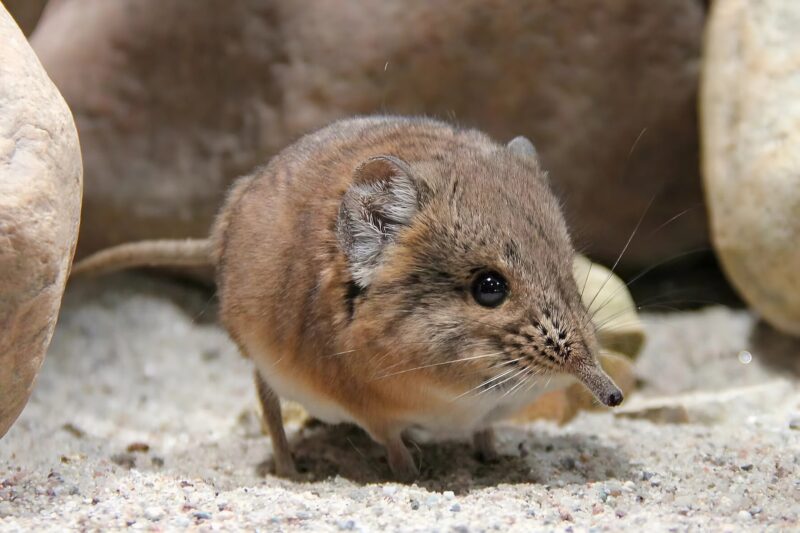
He reached under the sofa with the towel, gently trying to guide the animal out. For a moment, he managed to catch it. It squirmed and wriggled, but he held on just long enough for me to get a clear look. My jaw dropped. I blinked twice, thinking my eyes were playing tricks on me. 😳👁️👁️
But no — it was real.
The creature wasn’t a rat.
It wasn’t a squirrel.
It wasn’t anything I expected to ever see inside my house.
It was… an Elephant Shrew. 🐘🐭✨
Yes — an Elephant Shrew! A tiny creature with a pointed snout, long legs, soft fur, and a tail almost as long as its body. Something that looked like it belonged in a nature documentary, not wedged under our living room furniture. 📺🌿😅

My husband carefully released it outside, and the moment its little feet touched the grass, it darted away with impressive speed, disappearing into a bush like a miniature jungle explorer. 🌿💨🐾
When the adrenaline finally left my body, I started laughing — first quietly, then uncontrollably. The absurdity of it all hit me at once. My baby screamed his head off, my husband fought a wild animal with a dish towel, and the terrifying creature turned out to be one of the cutest mammals on Earth. 😂🍼💞
For the rest of the day, we could barely talk about anything else. Every time we tried, we ended up laughing again. Even my baby pointed at the sofa nervously, then giggled as if he knew he had survived a great adventure. 🛋️👶🌟
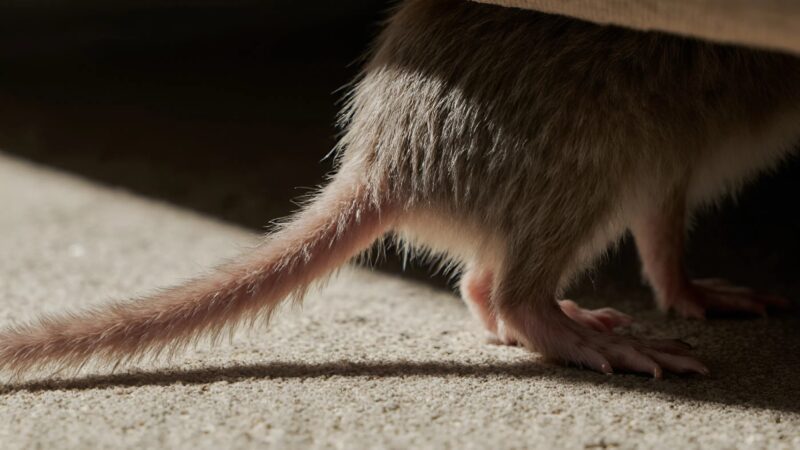
Now, every time someone visits, my husband proudly tells the story.
“Not everyone finds an Elephant Shrew in their living room,” he says.
And honestly… he’s right. 😄📖🐘🐭
I was in the bedroom, folding tiny clothes and enjoying one of those rare moments of calm that come with having a baby. The house was quiet — too quiet, actually — until a sudden, sharp scream shattered everything. It was my baby’s voice. A sound so raw, so frightened, that my heart jumped straight into my throat. 😰🍼💥
I dropped everything and sprinted toward the living room, already imagining a hundred awful possibilities. But nothing — absolutely nothing — could have prepared me for what I saw when I burst through the doorway. 😳🚪
My baby had climbed onto a chair, gripping the backrest with trembling hands. His eyes were huge, staring at something below him. For a split second, I couldn’t understand what he was looking at… until I followed his gaze. 🪑👶➡️😨

There, under the sofa, was something moving.
Something alive.
Something… with a long, thin tail and a body covered in fur. 🐾🕳️👀
I gasped so loudly that even my baby startled. My legs felt like jelly, but instinct pushed me forward. I grabbed my son off the chair, holding him tight while my heart pounded hard enough to echo in my ears. Whatever that creature was, it was real — and it was right inside our house. 😱💓👐

Horrified, I shouted for my husband. “Come here! Something is under the sofa!” My voice cracked, halfway between panic and disbelief. 🗣️😖
He ran in immediately, still drying his hands with a kitchen towel. He glanced at us, then at the sofa, and I could see a flicker of confusion cross his face before he slowly crouched down. 🔦🧑🔧
The creature moved again.
My husband jumped back, then laughed nervously — the exact laugh of someone who wants to sound calm but absolutely is not. “Okay… okay, that’s not a rat… and it’s definitely not a lizard,” he muttered. 😬💦

He reached under the sofa with the towel, gently trying to guide the animal out. For a moment, he managed to catch it. It squirmed and wriggled, but he held on just long enough for me to get a clear look. My jaw dropped. I blinked twice, thinking my eyes were playing tricks on me. 😳👁️👁️
But no — it was real.
The creature wasn’t a rat.
It wasn’t a squirrel.
It wasn’t anything I expected to ever see inside my house.
It was… an Elephant Shrew. 🐘🐭✨
Yes — an Elephant Shrew! A tiny creature with a pointed snout, long legs, soft fur, and a tail almost as long as its body. Something that looked like it belonged in a nature documentary, not wedged under our living room furniture. 📺🌿😅

My husband carefully released it outside, and the moment its little feet touched the grass, it darted away with impressive speed, disappearing into a bush like a miniature jungle explorer. 🌿💨🐾
When the adrenaline finally left my body, I started laughing — first quietly, then uncontrollably. The absurdity of it all hit me at once. My baby screamed his head off, my husband fought a wild animal with a dish towel, and the terrifying creature turned out to be one of the cutest mammals on Earth. 😂🍼💞
For the rest of the day, we could barely talk about anything else. Every time we tried, we ended up laughing again. Even my baby pointed at the sofa nervously, then giggled as if he knew he had survived a great adventure. 🛋️👶🌟

Now, every time someone visits, my husband proudly tells the story.
“Not everyone finds an Elephant Shrew in their living room,” he says.
And honestly… he’s right. 😄📖🐘🐭
It was the middle of a long journey—five hours of open road stretching behind and still two more ahead—when Ethan, a seasoned highway motorcycle rider, noticed a minivan pulled over on the shoulder. Its hazard lights were blinking in distress, and thick white steam was billowing out from beneath the hood.
Cars and trucks zoomed past without a second glance, some honking impatiently, others oblivious. But Ethan was different. Something about the scene tugged at him. With steady hands, he slowed his bike, pulled safely off the highway, and killed the engine. Clad in a worn leather jacket dusted with miles of road grime, boots heavy with the day’s journey, Ethan approached the vehicle calmly yet with quiet urgency.
At the rear of the minivan, a man was frantically rummaging through the trunk, searching for something desperately. Nearby, a woman stood holding her phone high above her head, but the screen stubbornly displayed “No Signal.”
“Need some help?” Ethan offered gently.
The man’s face turned pale, eyes wide with fear. “It’s not the van,” he whispered urgently. “It’s our daughter.”
Ethan stepped closer toward the open rear door of the minivan—and there he saw her.
A small girl, no older than six, curled tightly in her booster seat. Her skin was clammy with sweat; she trembled uncontrollably, and her lips had taken on a faint, worrying bluish tint.
The woman’s voice trembled as she explained, “I think it’s her blood sugar… We left her emergency kit at the last stop. We didn’t mean to—”
Without hesitation, Ethan turned on his heel and sprinted back to his motorcycle. From a weathered pouch secured to the side of his bike, he pulled out a granola bar and a bottle of orange juice.
“I always carry these with me,” he said softly as he knelt beside the minivan. “They’ve helped me through some tough spots before.”
The girl was barely conscious, barely responding. Ethan carefully cracked the juice bottle and pressed it gently to her lips, speaking to her in soothing tones.
“Come on, sweetheart. You’re stronger than this. You’ve got this.”
Minutes crawled by, but gradually color returned to her cheeks. Her shaking eased. Then, faint but unmistakable, a weak smile crossed her face.
The mother wept openly, overwhelmed with relief. The father’s voice was barely a whisper, repeated over and over, “Thank you… thank you.”
But Ethan’s attention was drawn to something else—something that made him stop breathing for a moment.
Taped to the back of the front passenger seat was a faded, worn photograph of a soldier in uniform. The same military unit patch that Ethan himself had worn years ago was visible on the soldier’s sleeve.
Ethan pointed to the photo. “Who’s this?”

The man blinked slowly. “That’s my brother, Daniel. He was killed in Afghanistan. He rode motorcycles, too.”
Ethan reached into his vest pocket and pulled out a small embroidered patch—the very same patch featured in the photograph.
He placed it gently in the little girl’s hand and said, “Your uncle saved my life once. Today, I’m just returning the favor.”
The father, whose name was Michael, looked stunned, as if seeing a ghost. “You knew Daniel?”
Ethan nodded solemnly, memories flooding back. “Yeah. Daniel pulled me out of a burning vehicle after an explosion in 2012. He stayed by my side for days at the field hospital, cracking jokes to keep me going.”
Michael slumped onto the gravel roadside, hands trembling. “He never told us about that. After he came home, he changed. Quiet. Different.”
Ethan understood that all too well.
Meanwhile, the little girl, whose name was Emma, was now sitting up, sipping small sips of juice. She looked at Ethan with wide, curious eyes.
“Are you a superhero?” she asked.
Ethan smiled warmly. “Nope. Just someone who knows what it’s like to need help.”
Her mother, Sarah, finally catching her breath, wiped tears from her cheeks. “We were scared,” she admitted. “Driving hours to get Emma to her specialist. Then the van overheated, and Emma started feeling worse. I panicked.”
Ethan lifted the hood again and inspected the engine. A small leak in the radiator was causing the overheating—not serious, but enough to cause trouble on a hot day.
“You’ve got enough coolant to make it about twenty miles to the next town,” Ethan said. “There’s a garage there. Ron runs it. Tell him Ethan sent you—he’ll help.”
Michael looked at Ethan, incredulous. “And you’re just going to leave it like that?”
Ethan shrugged. “What else is there to do?”
But Michael wasn’t done. As their phone finally found signal, he insisted on exchanging numbers, offering to repay Ethan, even if just for lunch.
Ethan politely declined. “Just get Emma to the doctor, that’s enough.”
But Emma had other ideas. She unbuckled herself, hopped out, and walked over to Ethan. Holding out the patch he’d given her, she said, “This is yours.”
Ethan knelt down to meet her gaze. “No, this is yours now. Your uncle would’ve wanted you to have it.”
Emma examined the patch carefully. “Did my uncle really save you?”
“He did,” Ethan confirmed softly. “And he never asked for anything in return. That was just who he was.”
Michael’s voice cracked as he spoke next. “He died two years after he got home. Motorcycle accident—some drunk driver ran a red light.”
Ethan closed his eyes briefly. He hadn’t heard the details. They hurt more than he expected.
“I’m sorry,” he said. “He deserved so much better.”
Sarah stepped closer, nodding. “Daniel used to say the people you help on the road are the family you choose. He lived by that.”
Ethan felt a lump rise in his throat. That was Daniel, through and through.
Emma tugged at Ethan’s sleeve. “Can I give you something?”
Before he could reply, she dashed back to the van and returned with a small, worn stuffed bear wearing a tiny leather vest.
“Uncle Daniel gave me this before he… before he left,” she said. “He said bikers look tough but have the biggest hearts. You can have it, to remember him.”
Ethan looked at the bear, then at Emma—brave, kind, and full of love despite everything. His chest tightened.
“You keep that, Emma. But I’ll carry him with me every day. Deal?”
Emma nodded tightly, clutching the bear.
Michael helped Sarah and Emma back into the van, then returned to Ethan.
“There’s something else,” Michael whispered. “Daniel left me a letter before he died. Said he owed someone a debt—a biker who helped him years ago when his bike broke down. He never found that person to thank them.”
Ethan frowned. “What do you mean?”
Michael handed him a folded, weathered letter from the glove box. Daniel had written it a week before his accident.
He described how a biker had stopped to help him on a deserted highway, offering water and fixing his bike without asking for payment. The biker wore a patch just like Ethan’s.
Ethan’s heart stopped.
“I was that guy,” he whispered. “I didn’t know it was him.”
Tears welled in Michael’s eyes as he handed Ethan the letter.
“Then this belongs to you.”
Ethan unfolded it carefully. The messy handwriting said:
To whoever stopped for me that day—I don’t know your name, but I know your heart. You didn’t have to help. But you did. Because of you, I made it home safe. I got to meet my niece, tell her the world still has good people. If I ever find you, I’ll spend my life trying to be half as decent as you were. Thank you.
Ethan tucked the letter into his vest pocket, feeling the weight not just of paper, but of a lifetime of kindness passed along.
Michael clasped Ethan’s shoulder. “He found you. Maybe not how he planned—but he found you.”
The three stood silently, connected by a bond forged through service, sacrifice, and unexpected kindness.
“Get Emma to that doctor,” Ethan said. “And when she’s older, tell her about today. Tell her kindness never disappears. It circles back when you need it most.”
Michael nodded solemnly. “I promise.”
As the minivan sputtered back onto the highway, Emma waved through the window. Ethan mounted his bike and looked out at the endless road before him—the road full of stories, chances, and connections waiting to be made.
He realized then that no ride is ever just a ride. Every stop, every helping hand sends ripples far beyond what we can see.
Marcus saved him once. Now, together, they’d saved Emma.
Maybe that’s life’s true meaning: passing kindness forward, even when we don’t know the cost, even when we think we’re alone.
The road ahead was open, and Ethan was ready to keep moving—ready to stop again, to help again.
Because that’s what it means to be human.
Cars and trucks zoomed past without a second glance, some honking impatiently, others oblivious. But Ethan was different. Something about the scene tugged at him. With steady hands, he slowed his bike, pulled safely off the highway, and killed the engine. Clad in a worn leather jacket dusted with miles of road grime, boots heavy with the day’s journey, Ethan approached the vehicle calmly yet with quiet urgency.
At the rear of the minivan, a man was frantically rummaging through the trunk, searching for something desperately. Nearby, a woman stood holding her phone high above her head, but the screen stubbornly displayed “No Signal.”
“Need some help?” Ethan offered gently.
The man’s face turned pale, eyes wide with fear. “It’s not the van,” he whispered urgently. “It’s our daughter.”
Ethan stepped closer toward the open rear door of the minivan—and there he saw her.
A small girl, no older than six, curled tightly in her booster seat. Her skin was clammy with sweat; she trembled uncontrollably, and her lips had taken on a faint, worrying bluish tint.
The woman’s voice trembled as she explained, “I think it’s her blood sugar… We left her emergency kit at the last stop. We didn’t mean to—”
Without hesitation, Ethan turned on his heel and sprinted back to his motorcycle. From a weathered pouch secured to the side of his bike, he pulled out a granola bar and a bottle of orange juice.
“I always carry these with me,” he said softly as he knelt beside the minivan. “They’ve helped me through some tough spots before.”
The girl was barely conscious, barely responding. Ethan carefully cracked the juice bottle and pressed it gently to her lips, speaking to her in soothing tones.
“Come on, sweetheart. You’re stronger than this. You’ve got this.”
Minutes crawled by, but gradually color returned to her cheeks. Her shaking eased. Then, faint but unmistakable, a weak smile crossed her face.
The mother wept openly, overwhelmed with relief. The father’s voice was barely a whisper, repeated over and over, “Thank you… thank you.”
But Ethan’s attention was drawn to something else—something that made him stop breathing for a moment.
Taped to the back of the front passenger seat was a faded, worn photograph of a soldier in uniform. The same military unit patch that Ethan himself had worn years ago was visible on the soldier’s sleeve.
Ethan pointed to the photo. “Who’s this?”

The man blinked slowly. “That’s my brother, Daniel. He was killed in Afghanistan. He rode motorcycles, too.”
Ethan reached into his vest pocket and pulled out a small embroidered patch—the very same patch featured in the photograph.
He placed it gently in the little girl’s hand and said, “Your uncle saved my life once. Today, I’m just returning the favor.”
The father, whose name was Michael, looked stunned, as if seeing a ghost. “You knew Daniel?”
Ethan nodded solemnly, memories flooding back. “Yeah. Daniel pulled me out of a burning vehicle after an explosion in 2012. He stayed by my side for days at the field hospital, cracking jokes to keep me going.”
Michael slumped onto the gravel roadside, hands trembling. “He never told us about that. After he came home, he changed. Quiet. Different.”
Ethan understood that all too well.
Meanwhile, the little girl, whose name was Emma, was now sitting up, sipping small sips of juice. She looked at Ethan with wide, curious eyes.
“Are you a superhero?” she asked.
Ethan smiled warmly. “Nope. Just someone who knows what it’s like to need help.”
Her mother, Sarah, finally catching her breath, wiped tears from her cheeks. “We were scared,” she admitted. “Driving hours to get Emma to her specialist. Then the van overheated, and Emma started feeling worse. I panicked.”
Ethan lifted the hood again and inspected the engine. A small leak in the radiator was causing the overheating—not serious, but enough to cause trouble on a hot day.
“You’ve got enough coolant to make it about twenty miles to the next town,” Ethan said. “There’s a garage there. Ron runs it. Tell him Ethan sent you—he’ll help.”
Michael looked at Ethan, incredulous. “And you’re just going to leave it like that?”
Ethan shrugged. “What else is there to do?”
But Michael wasn’t done. As their phone finally found signal, he insisted on exchanging numbers, offering to repay Ethan, even if just for lunch.
Ethan politely declined. “Just get Emma to the doctor, that’s enough.”
But Emma had other ideas. She unbuckled herself, hopped out, and walked over to Ethan. Holding out the patch he’d given her, she said, “This is yours.”
Ethan knelt down to meet her gaze. “No, this is yours now. Your uncle would’ve wanted you to have it.”
Emma examined the patch carefully. “Did my uncle really save you?”
“He did,” Ethan confirmed softly. “And he never asked for anything in return. That was just who he was.”
Michael’s voice cracked as he spoke next. “He died two years after he got home. Motorcycle accident—some drunk driver ran a red light.”
Ethan closed his eyes briefly. He hadn’t heard the details. They hurt more than he expected.
“I’m sorry,” he said. “He deserved so much better.”
Sarah stepped closer, nodding. “Daniel used to say the people you help on the road are the family you choose. He lived by that.”
Ethan felt a lump rise in his throat. That was Daniel, through and through.
Emma tugged at Ethan’s sleeve. “Can I give you something?”
Before he could reply, she dashed back to the van and returned with a small, worn stuffed bear wearing a tiny leather vest.
“Uncle Daniel gave me this before he… before he left,” she said. “He said bikers look tough but have the biggest hearts. You can have it, to remember him.”
Ethan looked at the bear, then at Emma—brave, kind, and full of love despite everything. His chest tightened.
“You keep that, Emma. But I’ll carry him with me every day. Deal?”
Emma nodded tightly, clutching the bear.
Michael helped Sarah and Emma back into the van, then returned to Ethan.
“There’s something else,” Michael whispered. “Daniel left me a letter before he died. Said he owed someone a debt—a biker who helped him years ago when his bike broke down. He never found that person to thank them.”
Ethan frowned. “What do you mean?”
Michael handed him a folded, weathered letter from the glove box. Daniel had written it a week before his accident.
He described how a biker had stopped to help him on a deserted highway, offering water and fixing his bike without asking for payment. The biker wore a patch just like Ethan’s.
Ethan’s heart stopped.
“I was that guy,” he whispered. “I didn’t know it was him.”
Tears welled in Michael’s eyes as he handed Ethan the letter.
“Then this belongs to you.”
Ethan unfolded it carefully. The messy handwriting said:
To whoever stopped for me that day—I don’t know your name, but I know your heart. You didn’t have to help. But you did. Because of you, I made it home safe. I got to meet my niece, tell her the world still has good people. If I ever find you, I’ll spend my life trying to be half as decent as you were. Thank you.
Ethan tucked the letter into his vest pocket, feeling the weight not just of paper, but of a lifetime of kindness passed along.
Michael clasped Ethan’s shoulder. “He found you. Maybe not how he planned—but he found you.”
The three stood silently, connected by a bond forged through service, sacrifice, and unexpected kindness.
“Get Emma to that doctor,” Ethan said. “And when she’s older, tell her about today. Tell her kindness never disappears. It circles back when you need it most.”
Michael nodded solemnly. “I promise.”
As the minivan sputtered back onto the highway, Emma waved through the window. Ethan mounted his bike and looked out at the endless road before him—the road full of stories, chances, and connections waiting to be made.
He realized then that no ride is ever just a ride. Every stop, every helping hand sends ripples far beyond what we can see.
Marcus saved him once. Now, together, they’d saved Emma.
Maybe that’s life’s true meaning: passing kindness forward, even when we don’t know the cost, even when we think we’re alone.
The road ahead was open, and Ethan was ready to keep moving—ready to stop again, to help again.
Because that’s what it means to be human.
Publicly mocking a war hero by pouring hot coffee on him seemed like a reckless, cruel act. But what happened next in that quiet coffee shop left everyone utterly speechless, transforming a moment of humiliation into a powerful testament to respect, courage, and redemption.
The incident began with two simple yet devastating mistakes.
The first mistake was when the man scoffed and called the veteran “Grandpa Soldier” in a mocking tone.
The second was when he cruelly laughed the moment the scorching latte splashed across the veteran’s lap.
Frank Reynolds, a 78-year-old Navy veteran, had endured a lifetime of challenges but maintained a quiet dignity that refused to be broken. That day, despite the insults—the cutting in line, the taunts about his trembling hands, and the dismissive sneers calling his Navy Cross a mere “participation trophy”—he said not a single word.
He stood silently, soaked by the scalding coffee and drowning in humiliation, holding onto the last fragments of his pride in a world that seemed to have forgotten the true meaning of honor.
Then, the door to the coffee shop opened.
Five men stepped inside, filling the entrance without a single word.
They weren’t law enforcement. They weren’t security guards. But their presence was immediately commanding.
Clad in leather jackets, their stern eyes piercing through the room, and adorned with the unmistakable Death Head patches on their backs, the men were unmistakably members of the Hells Angels motorcycle club.
The atmosphere shifted instantly; the air grew heavy, almost electric with tension.
The leader, a man with a striking silver beard and arms as strong as steel cables, surveyed the scene: the spilled coffee on Frank’s pants, the three suited men filming and sneering, and the Navy Cross still proudly hanging around Frank’s neck.
He stepped forward and addressed Frank—not the hecklers—with quiet authority, “Is there a problem here, Chief?”
Brad, the man responsible—wearing an expensive Rolex and a smug grin—opened his mouth to reply but quickly shut it. The biker hadn’t even glanced in his direction.
Frank straightened his spine just enough to show he was still standing tall.
Behind the silver-bearded biker, another man cracked his knuckles with a sound loud enough to serve as a warning.
Suddenly, the suited men seemed to remember they had somewhere important to be, somewhere far from this coffee shop.
They hurriedly retreated, leaving behind one item—Brad’s phone—still recording the entire confrontation with crystal-clear audio and full-framed faces.
What happened next wasn’t what anyone expected.
The bikers didn’t confront the men or escalate the conflict.
Instead, they pulled out chairs.
Not for intimidation. Not for a fight.
But simply to sit.
The silver-bearded leader nodded to Marissa, the barista still pale from the shock. “Two eggs, black coffee, and whatever the Chief is having.”
Marissa nodded quietly and moved behind the espresso machine.
Frank, still processing the surreal scene, looked at the leader and asked, “You… know me?”
“Not yet,” the biker answered, sliding into the booth opposite him. “But we know exactly who you are.”
Another biker gently picked up Frank’s cane, resting it carefully beside his chair.
The bikers remained mostly silent, keeping vigilant watch on the door as if guarding a VIP.
Frank blinked, trying to make sense of the moment.
The silver-bearded man extended his hand. “Name’s Gideon. United States Marine Corps. ’89 to ’01. Afghanistan and some places the world forgot.”
Frank shook the offered hand with respect, feeling its firm grip.
“You Navy?”
“Carrier man,” Frank replied softly. “USS Enterprise.”

Gideon nodded with understanding. “That medal you wear isn’t just some decoration. It’s earned. I once saw your name in a Navy history documentary. The man who jumped off the Enterprise during a storm. Saved three lives, lost twenty-seven. A legend.”
Frank lowered his gaze, voice barely a whisper. “It still haunts me every night.”
Gideon leaned forward. “Then you remember their names. And that’s the kind of man who deserves far more than a coffee spill.”
One biker slid Brad’s abandoned phone across the table. “You want us to delete this? Done. Want it online? We know the right places.”
Frank hesitated. “I don’t want revenge. I just wanted to be seen. To be respected. That’s all.”
Gideon nodded slowly. “Respect sometimes needs a little help finding its way back.”
The rest of the morning passed in peaceful silence.
The bikers ate their breakfast quietly, sipping coffee, while Frank thanked Marissa for a fresh cup and a dry napkin.
When Frank finally rose to leave, something remarkable happened.
Every customer in the shop stood with him.
Quietly.
Respectfully.
As if the coffee shop was a sanctuary and Frank was finally being seen for who he truly was.
He didn’t shed a tear right then.
But later, stepping out into the rain, he noticed one biker walking him to his car, a warm blanket draped over the backseat.
Tears fell freely, unashamed.
Frank never asked why the bikers had come.
Nor how they found him.
He didn’t have to.
Two days later, the video surfaced online.
No flashy edits, just raw footage: three men mocking a war hero, followed by five bikers arriving like karma incarnate.
The video title read: “He Laughed at a War Hero. Then Real Men Walked In.”
Within hours, the clip went viral—over a million views.
Brad’s name trended. Not for praise, but for shame.
Brad was a corporate consultant, a junior partner at a firm boasting “veteran support initiatives.” By noon, his LinkedIn was wiped clean. By evening, his company announced he was no longer employed.
But the real twist came a week later.
Frank received a handwritten letter.
Shaky but sincere, it read:
Dear Mr. Reynolds,
I’m sorry. I watched the video and saw myself from the outside. I didn’t recognize the man I was being.
I lost my father last year—a Navy man. I’ve been angry ever since: at the world, at myself, at everything. But none of that gave me the right to treat you that way.
What I did was disgusting. The worst part is, you still showed me grace.
I’m getting help. Real help. No excuses. I just wanted you to know you didn’t deserve any of it.
Sincerely,
Bradley Collins
Frank read it twice before tucking it into a drawer beside a faded photo of his old crew, taken just before the storm that forever changed his life.
He never replied.
But he never threw the letter away.
Weeks passed. The story faded.
But quietly, Frank’s life transformed.
A local high school invited him to speak on Veterans Day.
A church group volunteered to repair his front porch at no cost.
And Joe’s Cup & Chow renamed their corner table—the Captain’s Seat—with a brass plaque: Reserved for Chief Frank Reynolds, USS Enterprise.
The best moment came unexpectedly.
One morning, Marissa brought over his coffee, beaming.
“There’s someone here to see you.”
Frank turned to see Brad—no suit, just clean jeans, a fresh face, and a cup of black coffee in hand. He held a folder.
“I applied for the VA volunteer program,” Brad said quietly. “They said I needed a sponsor. A letter of recommendation.”
He placed the folder on the table.
“I don’t deserve it from you yet. But I want to earn it.”
Frank studied him long and then invited him to sit.
They talked for over an hour.
Not about the past.
But about service, second chances, and living with the knowledge you once played the villain in someone’s story—and the rare chance to change the ending.
Later that year, Brad was volunteering at the local VA hospital three times a week.
No cameras.
No PR stunts.
Just showing up.
Frank never mentioned the viral video again.
But the town noticed a change.
More patience.
More thank-yous.
Even teenagers started calling him “Sir.”
Joe’s Cup & Chow grew busier.
Locals and visitors who’d seen the video came to sit where the story unfolded.
Marissa framed a photo near the register: Frank in uniform, smiling beside Gideon and the bikers.
Gideon and his crew still visited sometimes.
No speeches.
No drama.
Just respect, bacon, and hot coffee that stayed exactly where it belonged.
The lesson here is simple:
You never know who you’re mocking.
You never know who’s watching.
And sometimes, the world gives you a chance to be better than you were before.
If this story moved you, share it.
Because the world could always use more respect—and more second chances.
The incident began with two simple yet devastating mistakes.
The first mistake was when the man scoffed and called the veteran “Grandpa Soldier” in a mocking tone.
The second was when he cruelly laughed the moment the scorching latte splashed across the veteran’s lap.
Frank Reynolds, a 78-year-old Navy veteran, had endured a lifetime of challenges but maintained a quiet dignity that refused to be broken. That day, despite the insults—the cutting in line, the taunts about his trembling hands, and the dismissive sneers calling his Navy Cross a mere “participation trophy”—he said not a single word.
He stood silently, soaked by the scalding coffee and drowning in humiliation, holding onto the last fragments of his pride in a world that seemed to have forgotten the true meaning of honor.
Then, the door to the coffee shop opened.
Five men stepped inside, filling the entrance without a single word.
They weren’t law enforcement. They weren’t security guards. But their presence was immediately commanding.
Clad in leather jackets, their stern eyes piercing through the room, and adorned with the unmistakable Death Head patches on their backs, the men were unmistakably members of the Hells Angels motorcycle club.
The atmosphere shifted instantly; the air grew heavy, almost electric with tension.
The leader, a man with a striking silver beard and arms as strong as steel cables, surveyed the scene: the spilled coffee on Frank’s pants, the three suited men filming and sneering, and the Navy Cross still proudly hanging around Frank’s neck.
He stepped forward and addressed Frank—not the hecklers—with quiet authority, “Is there a problem here, Chief?”
Brad, the man responsible—wearing an expensive Rolex and a smug grin—opened his mouth to reply but quickly shut it. The biker hadn’t even glanced in his direction.
Frank straightened his spine just enough to show he was still standing tall.
Behind the silver-bearded biker, another man cracked his knuckles with a sound loud enough to serve as a warning.
Suddenly, the suited men seemed to remember they had somewhere important to be, somewhere far from this coffee shop.
They hurriedly retreated, leaving behind one item—Brad’s phone—still recording the entire confrontation with crystal-clear audio and full-framed faces.
What happened next wasn’t what anyone expected.
The bikers didn’t confront the men or escalate the conflict.
Instead, they pulled out chairs.
Not for intimidation. Not for a fight.
But simply to sit.
The silver-bearded leader nodded to Marissa, the barista still pale from the shock. “Two eggs, black coffee, and whatever the Chief is having.”
Marissa nodded quietly and moved behind the espresso machine.
Frank, still processing the surreal scene, looked at the leader and asked, “You… know me?”
“Not yet,” the biker answered, sliding into the booth opposite him. “But we know exactly who you are.”
Another biker gently picked up Frank’s cane, resting it carefully beside his chair.
The bikers remained mostly silent, keeping vigilant watch on the door as if guarding a VIP.
Frank blinked, trying to make sense of the moment.
The silver-bearded man extended his hand. “Name’s Gideon. United States Marine Corps. ’89 to ’01. Afghanistan and some places the world forgot.”
Frank shook the offered hand with respect, feeling its firm grip.
“You Navy?”
“Carrier man,” Frank replied softly. “USS Enterprise.”

Gideon nodded with understanding. “That medal you wear isn’t just some decoration. It’s earned. I once saw your name in a Navy history documentary. The man who jumped off the Enterprise during a storm. Saved three lives, lost twenty-seven. A legend.”
Frank lowered his gaze, voice barely a whisper. “It still haunts me every night.”
Gideon leaned forward. “Then you remember their names. And that’s the kind of man who deserves far more than a coffee spill.”
One biker slid Brad’s abandoned phone across the table. “You want us to delete this? Done. Want it online? We know the right places.”
Frank hesitated. “I don’t want revenge. I just wanted to be seen. To be respected. That’s all.”
Gideon nodded slowly. “Respect sometimes needs a little help finding its way back.”
The rest of the morning passed in peaceful silence.
The bikers ate their breakfast quietly, sipping coffee, while Frank thanked Marissa for a fresh cup and a dry napkin.
When Frank finally rose to leave, something remarkable happened.
Every customer in the shop stood with him.
Quietly.
Respectfully.
As if the coffee shop was a sanctuary and Frank was finally being seen for who he truly was.
He didn’t shed a tear right then.
But later, stepping out into the rain, he noticed one biker walking him to his car, a warm blanket draped over the backseat.
Tears fell freely, unashamed.
Frank never asked why the bikers had come.
Nor how they found him.
He didn’t have to.
Two days later, the video surfaced online.
No flashy edits, just raw footage: three men mocking a war hero, followed by five bikers arriving like karma incarnate.
The video title read: “He Laughed at a War Hero. Then Real Men Walked In.”
Within hours, the clip went viral—over a million views.
Brad’s name trended. Not for praise, but for shame.
Brad was a corporate consultant, a junior partner at a firm boasting “veteran support initiatives.” By noon, his LinkedIn was wiped clean. By evening, his company announced he was no longer employed.
But the real twist came a week later.
Frank received a handwritten letter.
Shaky but sincere, it read:
Dear Mr. Reynolds,
I’m sorry. I watched the video and saw myself from the outside. I didn’t recognize the man I was being.
I lost my father last year—a Navy man. I’ve been angry ever since: at the world, at myself, at everything. But none of that gave me the right to treat you that way.
What I did was disgusting. The worst part is, you still showed me grace.
I’m getting help. Real help. No excuses. I just wanted you to know you didn’t deserve any of it.
Sincerely,
Bradley Collins
Frank read it twice before tucking it into a drawer beside a faded photo of his old crew, taken just before the storm that forever changed his life.
He never replied.
But he never threw the letter away.
Weeks passed. The story faded.
But quietly, Frank’s life transformed.
A local high school invited him to speak on Veterans Day.
A church group volunteered to repair his front porch at no cost.
And Joe’s Cup & Chow renamed their corner table—the Captain’s Seat—with a brass plaque: Reserved for Chief Frank Reynolds, USS Enterprise.
The best moment came unexpectedly.
One morning, Marissa brought over his coffee, beaming.
“There’s someone here to see you.”
Frank turned to see Brad—no suit, just clean jeans, a fresh face, and a cup of black coffee in hand. He held a folder.
“I applied for the VA volunteer program,” Brad said quietly. “They said I needed a sponsor. A letter of recommendation.”
He placed the folder on the table.
“I don’t deserve it from you yet. But I want to earn it.”
Frank studied him long and then invited him to sit.
They talked for over an hour.
Not about the past.
But about service, second chances, and living with the knowledge you once played the villain in someone’s story—and the rare chance to change the ending.
Later that year, Brad was volunteering at the local VA hospital three times a week.
No cameras.
No PR stunts.
Just showing up.
Frank never mentioned the viral video again.
But the town noticed a change.
More patience.
More thank-yous.
Even teenagers started calling him “Sir.”
Joe’s Cup & Chow grew busier.
Locals and visitors who’d seen the video came to sit where the story unfolded.
Marissa framed a photo near the register: Frank in uniform, smiling beside Gideon and the bikers.
Gideon and his crew still visited sometimes.
No speeches.
No drama.
Just respect, bacon, and hot coffee that stayed exactly where it belonged.
The lesson here is simple:
You never know who you’re mocking.
You never know who’s watching.
And sometimes, the world gives you a chance to be better than you were before.
If this story moved you, share it.
Because the world could always use more respect—and more second chances.
At my daughter’s wedding, forty-two motorcycle riders showed up without an invitation and blocked the church doors, preventing everyone from entering. I told them they were ruining the most significant day of her life, yelled at them to move, and threatened to call the police.
“Ma’am, we can’t let this wedding happen,” the lead biker, a huge man with scars all over his arms, stated as he stood there staring at me through tears. Your daughter is unaware of her true spouse.
I informed him that David was a well-respected attorney from a decent family and that he had no right to meddle, and that he was crazy.
My blood ran cold when he produced a folder with pictures and medical data, and I realized that these frightful bikers might be the only thing separating my daughter from a monster.
Twenty minutes was the estimated start time for the wedding. This wall of leather and denim refused to move as two hundred visitors attempted to enter St. Mary’s Cathedral.
“What’s going on, Mom?” My daughter, Sarah, showed up next to me in her white dress, looking gorgeous and perplexed. “Why are they not moving?” “It’s nothing, my love. Just a few insane individuals. Return inside; I’ll take care of this.”
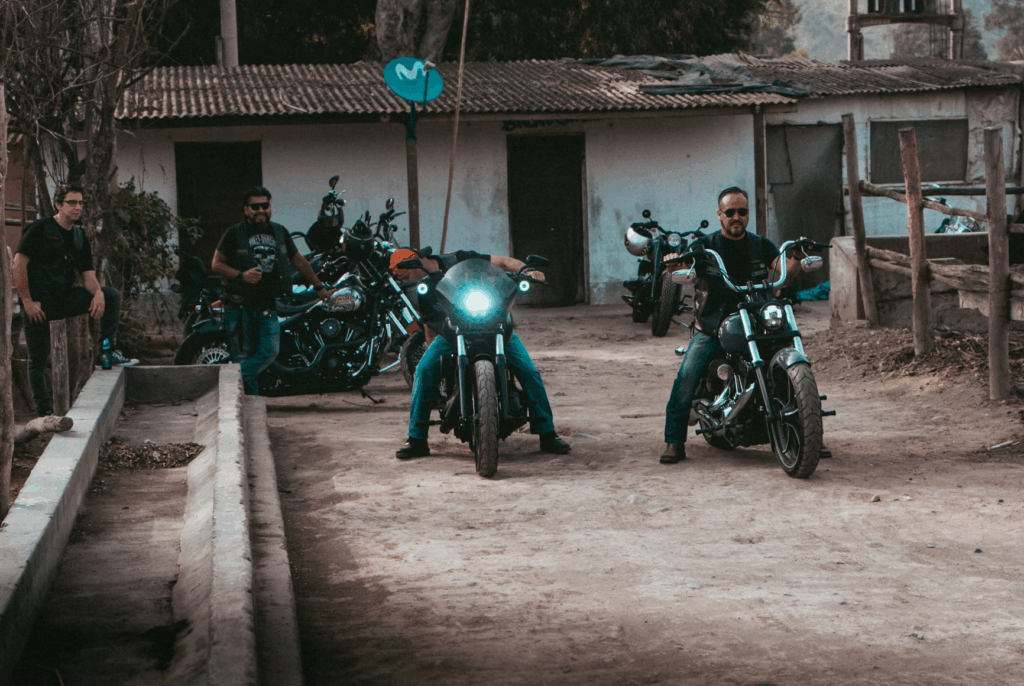
The lead biker, however, addressed her directly. “My name is Marcus Webb, Sarah. David Patterson and my sister Rachel were engaged three years ago. Two weeks prior to their wedding, she passed away.”
Sarah’s cheeks turned pale. David informed me that his fiancée passed away in a vehicle accident. Although that was tragic—
Marcus broke his voice as he stated, “It wasn’t a car accident.”
After six months of David’s torment, my sister threw herself from a bridge. She left a message. She left behind evidence. She abandoned everything. However, David’s family is wealthy and well-connected, and the lawsuit was dropped.
I stepped between them and firmly remarked, “That’s a lie.” “David is a decent guy. He would never—”
Another motorcyclist stepped forward with a phone and interrupted, saying, “Mom.” This is the suicide note written by Rachel Webb. Go through it.
Ready to disprove them, I grabbed the phone. However, my hands trembled at the words on the screen:
“I can no longer do this. In private, David is a monster. I can conceal the bruises, but I cannot conceal who he has turned into. He said that if I left, he would murder me. claimed that his family would ensure that I was not believed. He was correct. I filed two reports against him. The reports vanished both times. Marcus, I’m so sorry. Express your love for Mom. I tried, tell them all. However, I can’t wed him. I can’t live in constant fear. My only option is to do this.”
I muttered, “This could be fake,” but my voice lacked conviction.
Marcus took the packet out. There were medical documents within. pictures of fractured ribs, black eyes, and bruises. Filed police reports that were inexplicably closed. In texts, David branded Rachel useless, threatened her, and claimed she would regret trying to leave him.
Another biker whispered, “Show her the video.”
Marcus paused. “You don’t want to see—,” I said.
“Prove me,” Sarah insisted. She had been reading over my shoulder and had moved closer.
He opened his phone and played a video. A parking garage’s security footage. We observed David and Rachel fighting. I saw him take her arm, smack her across the face, and slam her against a car. He stood over her and screamed as he watched her fall to the ground.
Three weeks before to her passing, the date stamp was issued.
“Switch it off,” I muttered. “Please switch it off.”
Still wearing her wedding gown, Sarah sat motionless, gazing at the phone as if it were about to bite her. “David would never… He has never even spoken loudly to me.”
“Rachel also said that,” Marcus said. “For the initial year. He was flawless. romantic. Paying attention. Then everything changed when they became engaged. He began excluding her from his social circle. regulating her attire. She looked at her phone. It happened slowly. She was stuck by the time she recognized what was going on.”
Sarah’s voice was trembling as she said, “I need to talk to David.”
I firmly answered, “No,” as my mother’s instincts instantly screamed. “You won’t approach him.”
Marcus whispered softly, “Mrs. Chen, we didn’t want to do this. frightening everyone by interrupting a wedding. However, we were unable to allow another woman to wed him. Rachel’s passing couldn’t be ignored.”
“Why now?” I insisted. “How about calling the police? Why not—”
Another motorcyclist remarked, “We tried everything.” He had gentle eyes, a gray beard, and was older. “I’m Tom, Rachel’s uncle. In the last three years, we have visited the police seventeen times. All of the reports were buried. The father of David is a judge. The district attorney is his uncle. He is protected by the system.”
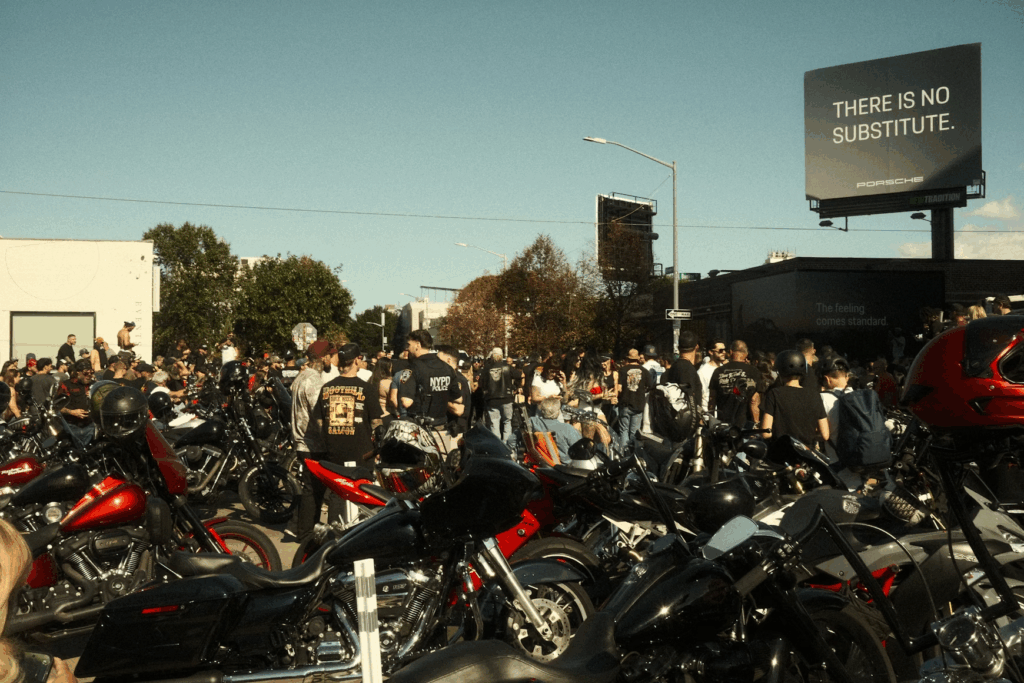
“You chose to scare my daughter on her wedding day, then?”
Marcus stated plainly, “We made the decision to save her life.” Since Rachel passed away, we have been keeping an eye on David. We looked into it after learning that he was engaged once more. discovered that he had previously done this. He had other victims besides Rachel.
He took away further files. Two more females. Inexplicably, the restraining orders against David were withdrawn for both. They both had medical records. To avoid him, one had relocated across the nation.
Tom clarified, “We found them.” “Asked them to testify and assist us in stopping him.” They were both too afraid. They were threatened, bought off, and forced to leave by his family.
Sarah had been quite silent. “Remember last month when I fell down the stairs, Mom?”
My blood turned to ice. “What?”
David and I were having a fight. regarding my work. Because the promotion would require more hours, he didn’t want me to accept it. I assumed he was merely jealous. However, I informed him that I was taking it anyhow. She put her hand on her sprained wrist. He took hold of me. I withdrew and collapsed. However, he took hold of me. Hard.
“What kept you from telling me?” I muttered.
“Because he expressed regret.” purchased flowers for me. claimed that the wedding was the only source of his stress. declared that it will never occur again.
The bikers looked at each other knowingly. This story was not new to them.
Marcus lowered himself to Sarah’s eye level. The same thing was said by my sister. Following the first, second, and tenth times. He was always sorry. had a reason for everything. always gave her the impression that she was at fault.
Then David emerged, squeezing through the throng of bewildered people. “What on earth is happening? Why aren’t you inside, Sarah?”
His tone was piercing. Furious. For the first time, I heard the edge beneath his typical charm.
“David,” Sarah replied cautiously, “they say you were previously engaged.” A woman by the name of Rachel Webb.
Carefully, his face went blank. “That’s from long ago. She lacked stability. What happened to her was tragic.”
Marcus stood to his full height and spoke the words, “You are the reason she killed herself.” since you defeated her. kept her under control. destroyed her.
David yelled, “That is slander.” “You’ll be arrested—”
“With what proof?” Tom posed a challenge. “The police reports that consistently vanish? The medical documents that are “lost”? Your family has a talent for making things disappear. However, they are unable to force us to leave.”
David lost his mask. I just caught a glimpse of anger in his eyes. Anger, cold and pure. Then it vanished, to be replaced by confused hurt.
You can’t believe these criminals, Sarah. Take a look. Most likely, they are attempting to extort money. This is—
“Give her your arm,” Marcus said.
David froze. “What?”
“Your forearm on the right. Present the scar to her.”
“I have nothing to show anyone—”
“That scar was given to you by Rachel,” Marcus persisted adamantly. “Retaliating for the last time you struck her.” Your arm was so deeply clawed by her that twelve stitches were required. It can be found in the ER notes from the two weeks prior to her passing.
Sarah gave David a look. “Give me your arm.”
“This is absurd—”
“David, show me your arm.”
He reluctantly and slowly pushed up his sleeve. It was there. The scar on his right forearm was lengthy and jagged.
David stumbled, “I got this from… from a biking accident.”
“You don’t ride a bike,” Sarah muttered.
There was silence in the crowd. This altercation is being witnessed by two hundred wedding guests.
David’s dad shoved his way through the throng. “This is harassment.” Right now, I’m going to phone the police—
“Do it, please,” Marcus answered coolly. “We would want to present them with all of our proof. When you want to bury another case, it’s great to have the media present. Because you’re going to do that, aren’t you? Make this disappear, just as you did with Rachel’s case.”
The face of Judge Patterson flushed. “You don’t have any evidence—”
Seventeen police reports are in our possession. Three distinct women’s medical records. CCTV footage. text messages. The suicide note written by Rachel. And—
“—we’ve already sent copies to every major news outlet in the state,” Marcus said, taking out his phone. It is obvious to everyone what sort of family you are if this wedding is called off tonight or tomorrow morning.
The audience burst out. Visitors were chatting, taking out their phones, and glancing between David and the motorcyclists. In real time, the meticulously crafted façade of the ideal lawyer from the ideal family was disintegrating.
When David’s mother showed up, she looked terrified. “You know David loves you, Sarah, my dear. These folks are simply—”
David interrupted her, “Mom,” in a tone of coldness I had never heard before. “Not assisting.”
That voice. That voice. Sarah winced.
Sarah retreated from David, saying, “I need to think.” “I require… I need a moment.”
She recoiled once more when David grabbed for her and said, “Sarah.”
I could tell everything from that flinch.
“Avoid touching her,” I stated to myself. “You have no right to touch my daughter.”
David’s mask fell off entirely. “You are to blame for this,” he growled at Marcus. “As if you were to blame for Rachel’s weakness—”

He left the sentence hanging. David was sent reeling when Marcus’s fist struck his jaw.
Marcus added softly, “That’s for my sister.”
As David’s relatives hurried to help him up, the motorcyclists around Sarah and me in a protective circle. Someone had phoned the police, and their sirens were coming closer.
“Regardless of the charges, we’ll accept them,” Tom declared. “Assault, trespassing, whatever.” Stopping this is worthwhile.
Sarah’s flawless wedding makeup was ruined, her mascara streaming, and she was crying. She asked no one in particular, “Was any of it real?” “Has he ever truly been who I believed him to be?”
“The start was genuine,” Marcus remarked softly. They get you that way. Rachel agreed. The first year was ideal. It was true. But the monster beneath it is, too.
The police showed up. Marcus’s group had ensured that the news vehicles did the same. By the time the cops separated everyone, reporters were asking questions, cameras were rolling, and the Patterson family’s long-kept secrets were coming to light.
David and Sarah never got married. While she recovered from what we subsequently realized was the early stages of the same abuse that had murdered Rachel, she spent six months at home.
Marcus was accused of violence and the bikers of trespassing. However, the charges were subsequently dismissed due to the case’s prominence, the evidence they had presented, and the other victims who came forward after realizing they weren’t alone.
David’s law license was revoked. For falsifying police records, his father was the subject of an investigation. The family’s standing was ruined.
Additionally, Rachel Webb’s case was at last thoroughly looked into.
Sarah served as the maid of honor at Marcus’s wedding two years later. She now considered the man who had interrupted her wedding to be a brother. I was now related to the motorcyclists who had frightened me that day.
One evening, Sarah informed me, “I would have married him.” “I would have married him if they hadn’t called off the wedding. And I would have become Rachel in a year or two. Otherwise, I would have been just another suicide victim.”
She keeps the wedding gown in her closet that she never wore. As a reminder that sometimes the most frightening people are the ones attempting to help you, she preserves it. And occasionally the true monster is the man wearing the pricey suit.
During his own wedding, Marcus made a tearful toast to Rachel. someone I was unable to save. However, who taught me to always be there for the people I can?
The wedding of my daughter was ruined by forty-two motorcycle riders. They ruined what should have been the most joyous day by frightening visitors, attacking the groom, and causing mayhem.
They also prevented my daughter’s death.
Love occasionally rides a Harley and dons leather. It can occasionally ruin your wedding and prevent you from making the greatest error of your life. And sometimes a group of bikers who won’t let another Rachel die are the only thing between you and a monster.
“Ma’am, we can’t let this wedding happen,” the lead biker, a huge man with scars all over his arms, stated as he stood there staring at me through tears. Your daughter is unaware of her true spouse.
I informed him that David was a well-respected attorney from a decent family and that he had no right to meddle, and that he was crazy.
My blood ran cold when he produced a folder with pictures and medical data, and I realized that these frightful bikers might be the only thing separating my daughter from a monster.
Twenty minutes was the estimated start time for the wedding. This wall of leather and denim refused to move as two hundred visitors attempted to enter St. Mary’s Cathedral.
“What’s going on, Mom?” My daughter, Sarah, showed up next to me in her white dress, looking gorgeous and perplexed. “Why are they not moving?” “It’s nothing, my love. Just a few insane individuals. Return inside; I’ll take care of this.”

The lead biker, however, addressed her directly. “My name is Marcus Webb, Sarah. David Patterson and my sister Rachel were engaged three years ago. Two weeks prior to their wedding, she passed away.”
Sarah’s cheeks turned pale. David informed me that his fiancée passed away in a vehicle accident. Although that was tragic—
Marcus broke his voice as he stated, “It wasn’t a car accident.”
After six months of David’s torment, my sister threw herself from a bridge. She left a message. She left behind evidence. She abandoned everything. However, David’s family is wealthy and well-connected, and the lawsuit was dropped.
I stepped between them and firmly remarked, “That’s a lie.” “David is a decent guy. He would never—”
Another motorcyclist stepped forward with a phone and interrupted, saying, “Mom.” This is the suicide note written by Rachel Webb. Go through it.
Ready to disprove them, I grabbed the phone. However, my hands trembled at the words on the screen:
“I can no longer do this. In private, David is a monster. I can conceal the bruises, but I cannot conceal who he has turned into. He said that if I left, he would murder me. claimed that his family would ensure that I was not believed. He was correct. I filed two reports against him. The reports vanished both times. Marcus, I’m so sorry. Express your love for Mom. I tried, tell them all. However, I can’t wed him. I can’t live in constant fear. My only option is to do this.”
I muttered, “This could be fake,” but my voice lacked conviction.
Marcus took the packet out. There were medical documents within. pictures of fractured ribs, black eyes, and bruises. Filed police reports that were inexplicably closed. In texts, David branded Rachel useless, threatened her, and claimed she would regret trying to leave him.
Another biker whispered, “Show her the video.”
Marcus paused. “You don’t want to see—,” I said.
“Prove me,” Sarah insisted. She had been reading over my shoulder and had moved closer.
He opened his phone and played a video. A parking garage’s security footage. We observed David and Rachel fighting. I saw him take her arm, smack her across the face, and slam her against a car. He stood over her and screamed as he watched her fall to the ground.
Three weeks before to her passing, the date stamp was issued.
“Switch it off,” I muttered. “Please switch it off.”
Still wearing her wedding gown, Sarah sat motionless, gazing at the phone as if it were about to bite her. “David would never… He has never even spoken loudly to me.”
“Rachel also said that,” Marcus said. “For the initial year. He was flawless. romantic. Paying attention. Then everything changed when they became engaged. He began excluding her from his social circle. regulating her attire. She looked at her phone. It happened slowly. She was stuck by the time she recognized what was going on.”
Sarah’s voice was trembling as she said, “I need to talk to David.”
I firmly answered, “No,” as my mother’s instincts instantly screamed. “You won’t approach him.”
Marcus whispered softly, “Mrs. Chen, we didn’t want to do this. frightening everyone by interrupting a wedding. However, we were unable to allow another woman to wed him. Rachel’s passing couldn’t be ignored.”
“Why now?” I insisted. “How about calling the police? Why not—”
Another motorcyclist remarked, “We tried everything.” He had gentle eyes, a gray beard, and was older. “I’m Tom, Rachel’s uncle. In the last three years, we have visited the police seventeen times. All of the reports were buried. The father of David is a judge. The district attorney is his uncle. He is protected by the system.”

“You chose to scare my daughter on her wedding day, then?”
Marcus stated plainly, “We made the decision to save her life.” Since Rachel passed away, we have been keeping an eye on David. We looked into it after learning that he was engaged once more. discovered that he had previously done this. He had other victims besides Rachel.
He took away further files. Two more females. Inexplicably, the restraining orders against David were withdrawn for both. They both had medical records. To avoid him, one had relocated across the nation.
Tom clarified, “We found them.” “Asked them to testify and assist us in stopping him.” They were both too afraid. They were threatened, bought off, and forced to leave by his family.
Sarah had been quite silent. “Remember last month when I fell down the stairs, Mom?”
My blood turned to ice. “What?”
David and I were having a fight. regarding my work. Because the promotion would require more hours, he didn’t want me to accept it. I assumed he was merely jealous. However, I informed him that I was taking it anyhow. She put her hand on her sprained wrist. He took hold of me. I withdrew and collapsed. However, he took hold of me. Hard.
“What kept you from telling me?” I muttered.
“Because he expressed regret.” purchased flowers for me. claimed that the wedding was the only source of his stress. declared that it will never occur again.
The bikers looked at each other knowingly. This story was not new to them.
Marcus lowered himself to Sarah’s eye level. The same thing was said by my sister. Following the first, second, and tenth times. He was always sorry. had a reason for everything. always gave her the impression that she was at fault.
Then David emerged, squeezing through the throng of bewildered people. “What on earth is happening? Why aren’t you inside, Sarah?”
His tone was piercing. Furious. For the first time, I heard the edge beneath his typical charm.
“David,” Sarah replied cautiously, “they say you were previously engaged.” A woman by the name of Rachel Webb.
Carefully, his face went blank. “That’s from long ago. She lacked stability. What happened to her was tragic.”
Marcus stood to his full height and spoke the words, “You are the reason she killed herself.” since you defeated her. kept her under control. destroyed her.
David yelled, “That is slander.” “You’ll be arrested—”
“With what proof?” Tom posed a challenge. “The police reports that consistently vanish? The medical documents that are “lost”? Your family has a talent for making things disappear. However, they are unable to force us to leave.”
David lost his mask. I just caught a glimpse of anger in his eyes. Anger, cold and pure. Then it vanished, to be replaced by confused hurt.
You can’t believe these criminals, Sarah. Take a look. Most likely, they are attempting to extort money. This is—
“Give her your arm,” Marcus said.
David froze. “What?”
“Your forearm on the right. Present the scar to her.”
“I have nothing to show anyone—”
“That scar was given to you by Rachel,” Marcus persisted adamantly. “Retaliating for the last time you struck her.” Your arm was so deeply clawed by her that twelve stitches were required. It can be found in the ER notes from the two weeks prior to her passing.
Sarah gave David a look. “Give me your arm.”
“This is absurd—”
“David, show me your arm.”
He reluctantly and slowly pushed up his sleeve. It was there. The scar on his right forearm was lengthy and jagged.
David stumbled, “I got this from… from a biking accident.”
“You don’t ride a bike,” Sarah muttered.
There was silence in the crowd. This altercation is being witnessed by two hundred wedding guests.
David’s dad shoved his way through the throng. “This is harassment.” Right now, I’m going to phone the police—
“Do it, please,” Marcus answered coolly. “We would want to present them with all of our proof. When you want to bury another case, it’s great to have the media present. Because you’re going to do that, aren’t you? Make this disappear, just as you did with Rachel’s case.”
The face of Judge Patterson flushed. “You don’t have any evidence—”
Seventeen police reports are in our possession. Three distinct women’s medical records. CCTV footage. text messages. The suicide note written by Rachel. And—
“—we’ve already sent copies to every major news outlet in the state,” Marcus said, taking out his phone. It is obvious to everyone what sort of family you are if this wedding is called off tonight or tomorrow morning.
The audience burst out. Visitors were chatting, taking out their phones, and glancing between David and the motorcyclists. In real time, the meticulously crafted façade of the ideal lawyer from the ideal family was disintegrating.
When David’s mother showed up, she looked terrified. “You know David loves you, Sarah, my dear. These folks are simply—”
David interrupted her, “Mom,” in a tone of coldness I had never heard before. “Not assisting.”
That voice. That voice. Sarah winced.
Sarah retreated from David, saying, “I need to think.” “I require… I need a moment.”
She recoiled once more when David grabbed for her and said, “Sarah.”
I could tell everything from that flinch.
“Avoid touching her,” I stated to myself. “You have no right to touch my daughter.”
David’s mask fell off entirely. “You are to blame for this,” he growled at Marcus. “As if you were to blame for Rachel’s weakness—”

He left the sentence hanging. David was sent reeling when Marcus’s fist struck his jaw.
Marcus added softly, “That’s for my sister.”
As David’s relatives hurried to help him up, the motorcyclists around Sarah and me in a protective circle. Someone had phoned the police, and their sirens were coming closer.
“Regardless of the charges, we’ll accept them,” Tom declared. “Assault, trespassing, whatever.” Stopping this is worthwhile.
Sarah’s flawless wedding makeup was ruined, her mascara streaming, and she was crying. She asked no one in particular, “Was any of it real?” “Has he ever truly been who I believed him to be?”
“The start was genuine,” Marcus remarked softly. They get you that way. Rachel agreed. The first year was ideal. It was true. But the monster beneath it is, too.
The police showed up. Marcus’s group had ensured that the news vehicles did the same. By the time the cops separated everyone, reporters were asking questions, cameras were rolling, and the Patterson family’s long-kept secrets were coming to light.
David and Sarah never got married. While she recovered from what we subsequently realized was the early stages of the same abuse that had murdered Rachel, she spent six months at home.
Marcus was accused of violence and the bikers of trespassing. However, the charges were subsequently dismissed due to the case’s prominence, the evidence they had presented, and the other victims who came forward after realizing they weren’t alone.
David’s law license was revoked. For falsifying police records, his father was the subject of an investigation. The family’s standing was ruined.
Additionally, Rachel Webb’s case was at last thoroughly looked into.
Sarah served as the maid of honor at Marcus’s wedding two years later. She now considered the man who had interrupted her wedding to be a brother. I was now related to the motorcyclists who had frightened me that day.
One evening, Sarah informed me, “I would have married him.” “I would have married him if they hadn’t called off the wedding. And I would have become Rachel in a year or two. Otherwise, I would have been just another suicide victim.”
She keeps the wedding gown in her closet that she never wore. As a reminder that sometimes the most frightening people are the ones attempting to help you, she preserves it. And occasionally the true monster is the man wearing the pricey suit.
During his own wedding, Marcus made a tearful toast to Rachel. someone I was unable to save. However, who taught me to always be there for the people I can?
The wedding of my daughter was ruined by forty-two motorcycle riders. They ruined what should have been the most joyous day by frightening visitors, attacking the groom, and causing mayhem.
They also prevented my daughter’s death.
Love occasionally rides a Harley and dons leather. It can occasionally ruin your wedding and prevent you from making the greatest error of your life. And sometimes a group of bikers who won’t let another Rachel die are the only thing between you and a monster.
 Top Video Viral
Top Video Viral